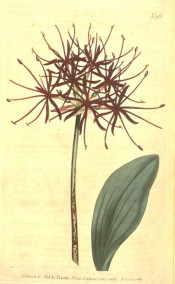Scadoxus multiflorus (Martyn) Raf.
Frost-tender bulbous perennial, with wavy-edged basal leaves and spherical heads of red flowers with conspicuous stamens, followed by orange berries, in summer. The leaves may be present or absent at flowering. To 60cm. Quite variable, with many geographical forms, many separately named in the early literature. [RHSE, Hortus, Baker Am.].
Horticultural & Botanical History
First botanically described by Martyn in 1795 as Haemanthus multiflorus [Monogr. s.p., t. 1795]. Placed in Scadoxus by Rafinesque in 1838 [Fl. Tellur. vol.44, p.19/1838].
‘This plant is said to have been in our European gardens so long ago as the year 1603; having, at that time been sent to Paris by the younger Robin from Guinea.’ [ABR pl.318/c.1803]. ‘It was introduced into this country in 1783, and is a very elegant plant, flowering at uncertain seasons. Our bulbs were received in 1822, since which time they have been flowering in succession.’ [LBC no.912/1825].
‘From the first establishment of a colony at Sierra Leone, the bulbs of this beautiful flower have frequently been imported from thence, and is rather common in our stoves. The spathe generally divides into three parts and is patent or reflected, not erect, as in Haemanthus coccineus, from which species it differs also in radication and foliation, the fibres growing from the summit of the bulb and the leaves, embracing one another at their bases, so as to form a spotted stalk, rising several inches above the ground; in all which circumstances it agrees with Haemanthus puniceus.
Being a native of so warm a climate as the Coast of Guinea, the bark-stove is necessary to its preservation; and even there few have been so successful as to flower the same plant repeatedly; though imported bulbs will blow without the aid of artificial heat.
Introduced into the Paris garden more than two hundred years ago by M. Robin, Jun. and figured at the time by Vallet in his Jardin du Roy Henry IV. Of this inaccurate figure, those of De Bry, Sweertius, Rudbeck, and Morison, are more or less mutilated copies; Seba’s is different and better; Nodder’s is excellent, and was drawn in 1795 from a plant which flowered at Mr. Parker’s, at South-Lambeth, among the first received from Sierra-Leone; ours was taken about the same time, from a bulb which flowered very weakly, but on account of its size appeared better suited to our work. The umbel frequently contains from forty to fixty blossoms.’ [BM t.961/1806]. LBC no.1948/1833 and FS p.122/1846.
History at Camden Park
It is very difficult to cultivate, which may account for its appearance only in the 1850 catalogue.
Notes
Published May 27, 2009 - 03:39 PM | Last updated Aug 09, 2012 - 05:02 PM
| Family | Amaryllidaceae |
|---|---|
| Category | |
| Region of origin | Tropical Africa |
| Synonyms |
|
| Common Name | |
| Name in the Camden Park Record | Haemanthus multiflorus
|
| Confidence level | high |


